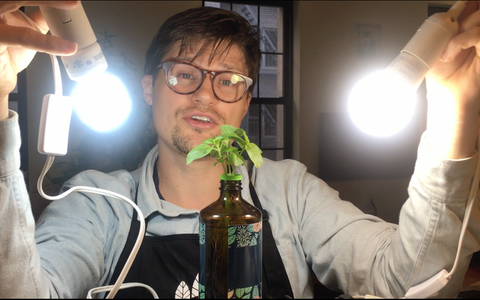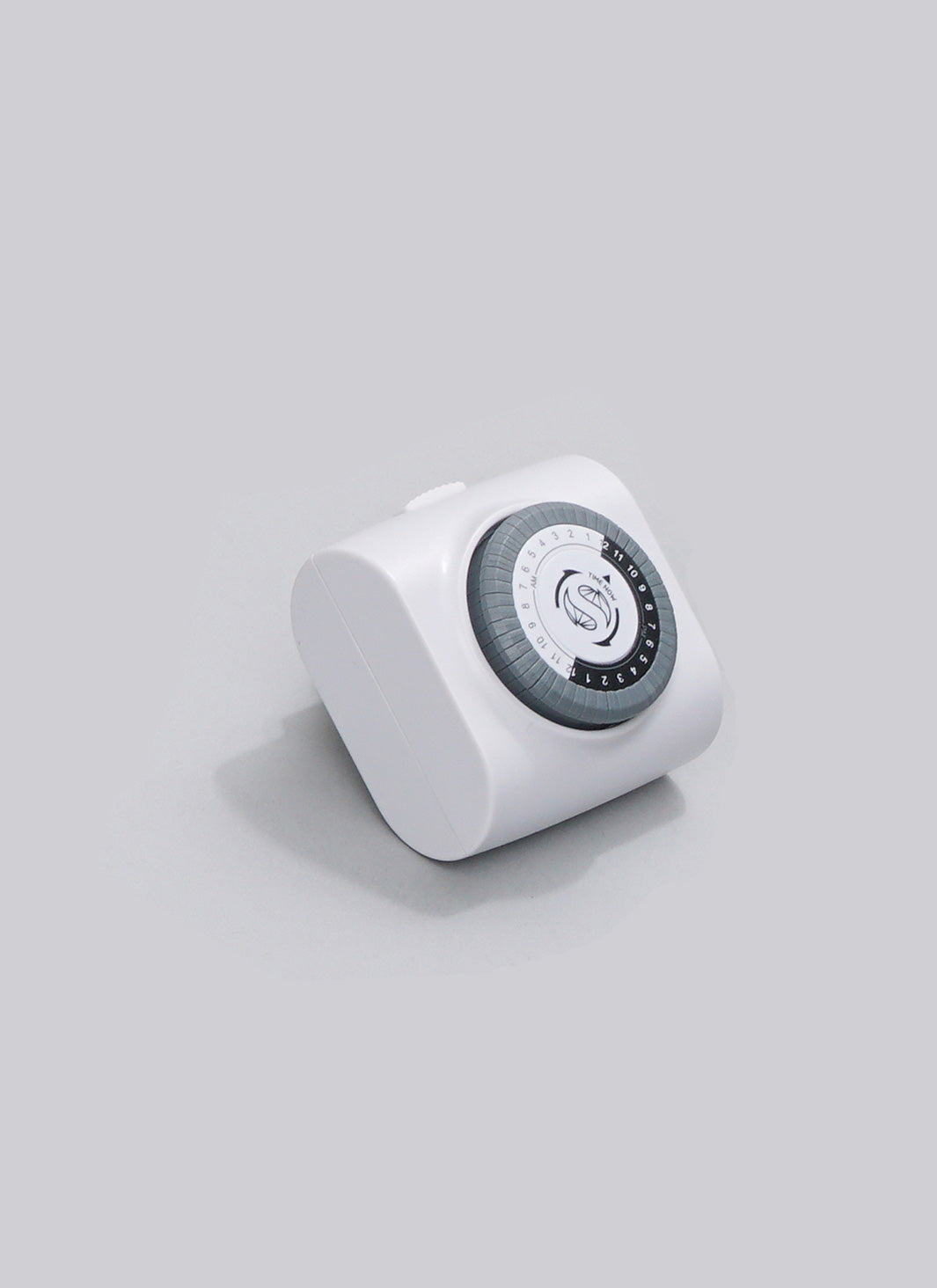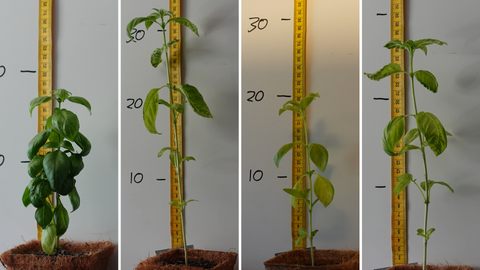Grow lights are a great way to boost your plants’ growth indoors, as well as extend the growing season. But with so many different types, choices, features, and claims made by manufacturers – it can be really hard to know what to look for.
Of all the aspects of indoor gardening, grow lights are one of the EASIEST areas to waste A LOT of money if you don’t know what you’re doing.
This blog is part of our larger series of grow light buying guides, and its focus is specifically on E26 screw-in bulbs. The E26 fitting is a standard connection type in the US and is similar to (although not identical to) E27 fittings which you will find elsewhere in the world.
Our hope is that by the end of this blog you will be able to confidently purchase an E26 grow light for your indoor garden.
Side note: in addition to this blog you should also download a copy of our free eBook while you’re here. It contains how-to guides for all the most common edible plants you can grow at home and is a great resource to keep handy for future reference. Get your free copy below.
Benefits Of An E26 LED Grow Light For A Small Indoor Garden Setup
The main benefits of an E26 LED screw-in indoor grow light are:
- They’re relatively affordable, and
- When paired with a lamp or housing of your choosing they offer an infinite array of options in terms of decor compatibility. That’s a nice way of saying that they don’t necessarily need to ‘look’ like an indoor grow light.

Energy Use: How To Measure Indoor Grow Light Intensity
The wattage of an indoor plant growing light bulb tells you how much electricity it consumes. Fortunately, today’s LED and CFL indoor grow light options are all fairly energy efficient, and the difference between a high and low energy user is likely less than $10 a year. We’ve included a simple calculator below that allows you to calculate the annual running cost of your indoor grow light.
Instructions to use the grow light calculator: Enter the wattage of your indoor plant growing light (add up the total, if you are using more than one), hours per day of usage, and electricity price and the spreadsheet will calculate your annual running cost.
Although it is important to understand and monitor your energy consumption, the truth is that your plants don’t really care how much energy your light consumes. Your plants care much more about how much useful light comes OUT of the grow light. The ratio between Energy In and Plant-Available Light out is known as the ‘efficacy’ of a grow light. Grow light efficacy varies widely.
To learn more about grow light efficacy and the various ways that grow lights are measured, we recommend reading our article, ‘Grow Lights For Indoor Plants – How To Measure It, and Understanding Watts, PPF, PPFD and DLI’.
Some manufacturers will also quote what’s known as an ‘incandescent equivalent’ wattage. What they’re trying to do here is tell you something about its brightness, by comparing it to the older type of incandescent light bulb.
Currently, on Amazon.com you will find indoor grow light bulbs listed as “100W”, but this is actually an ‘incandescent equivalent’ wattage and not a true wattage. We know because we have a tool for measuring wattage and we’ve tested these globes. So, not only is the units of ‘Wattage’ somewhat useless in evaluating grow lights but on top of this, some manufacturers don’t even tell you what the true wattage is (!!).
As we showed in our Video Review Of Amazon’s Best E26 Grow Bulbs you’ll notice there’s a huge difference between the CFL (compact fluorescent) and LED (light-emitting diode) type bulbs in terms of the PAR value they are able to generate per watt of energy consumed. We, therefore, have a strong preference for LED over CFL type screw-in bulbs.
Here are our best screw-in E26 indoor plant grow light bulbs based on efficacy. If you want to learn more about the best grow light bulbs on Amazon, click here:
| Grow Light |
|
|
|
| Features |
|
|
|
| Cons |
|
Color And Color Temperature: We Recommend A White / Yellow Indoor Plant Growing Light Bulb Over A Purple Indoor Grow Light
For small-scale garden setups that are placed in your living space, we have a very strong preference for white/yellow indoor grow lights over purple ones. Anything within the 2700K (warmer) to 5000K (cooler) range is going to be fine, and certainly much nicer to live with than a purple option.
If you live in a small apartment, or in a cold climate, then we’d suggest you look for something less than 3000K. These indoor grow lights have a ‘warm’ glow that gives a cozy feel.
By the way – we are not talking about regular house-globes here (those won’t work), our focus is only on plant-specific grow light bulbs that have the right spectral distribution to be suitable for indoor plants.
If you live in a very hot environment and would prefer to make your space feel cooler, then use a higher kelvin value (4000-5000K). In the UAE for example, cooler indoor grow light bulbs are preferred.
The reason some grow lights will emit a purple color is really just for legacy reasons. When indoor LED plant grow lights were first released a decade or two ago, they were far less efficient than they are today. For this reason, it made some sense (then) to omit ‘non-core’ light frequencies.
Today, however, that efficiency argument is far less valid. Plus, there are two more reasons why we think purple grow light is a bad idea for small indoor gardens:
- Although red and blue are critical for plant health, other frequencies are still important to plant health and can impact things like aroma, essential oils production, the color of the vegetation, and even taste. Light = food for plants, and we, therefore, recommend a balanced diet.
- Having a purple light in your house might seem like it has a ‘cool’ factor going on, but trust us – that lasts for about 10 minutes. After that it kinda sucks.
Check this article out if you want to learn more about why not to use purple grow lights.
Here Are Some Of The Best Indoor Grow Light Bulbs That Include Optics
Optics are the built-in lenses that some globes have that help direct the light towards the plant. Without them, light is going to get thrown in all different directions.
- A light that does not have optics (also known as non-directional) MUST be used with a lampshade.
- For lights that do have built-in optics, the lampshade is optional.
In this video, we talk more about optics and lampshades, as well as their importance in running up an efficient grow light setup.
Some of the best screw-in grow light bulbs for indoor plants are listed below.
|
Grow Light |
|
|
|
|
Features |
|
|
|
Please note that many of the product links in this blog are affiliate links. You will pay no more by using them to make your purchase, however, we do make a small commission which helps pay our bills so we can spend time writing blogs like this one.
Other Items You Will Need For A DIY Indoor Grow Light Setup
If you don’t already have a lampstand, then you’re going to need to buy one of those too. If you want to avoid having to turn the indoor grow light on and off every day, then you will also need a timer. These additional components are not super expensive, and in this video, we show you how to source all the components for less than $40.
|
Lamp Stand |
|
|
Why we like it: offers excellent adjustability at a reasonable price |
Why we like it: comes with an app that allows an on/off timer to be set from your phone. Also compatible with Google and Alexa. |
Learn More About Screw in Grow Light Bulbs And Indoor Gardening
If you’d like to learn more about screw-in indoor growing plant light bulbs and calculating grow light measurements, then you can grab a free copy of our Grow Light Calculators below.
Indoor Grow Light Comparison: Best Amazon LED Indoor Plant Growing Light Bulbs
If you’re curious about how to find the Best Screw-In E26 Grow Lights in 2022, then we recommend our accompanying article titled ‘Best LED Screw-In Grow Light On Amazon (2022 Edition): Screw-In Grow Light Bulbs Compared’.



















There are no comments for this article. Be the first one to leave a message!